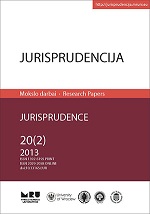Teismų santvarkos pagrindų formavimasis Lietuvoje (1918–1933)
Formation of the Judiciary Fundamental in Lithuania (1913–1933)
Author(s): Mindaugas MaksimaitisSubject(s): Law, Constitution, Jurisprudence
Published by: Mykolas Romeris University
Keywords: Lithuanian courts; judiciary; court history
Summary/Abstract: The article describes the problematic spots of the court system ordained by the temporary law during the inter-war period in Lithuania and the prolonged attempts of the authority to transform it into the permanent one. It demonstrates that there has been a constant involvement in this situation among the authority representatives and the institutions until the issue of the Judiciary Act in 1933. The new legislation has been prepared, even though not all of it has been implemented. The first legislation on judiciary of an independent Lithuania was enacted in 1918 as the Temporary Act on Lithuanian Courts and their Operation. It acknowledged the weak spots such as the procedure for assigning peace judges, no provision for cassation, elimination of jury as well as no limitations of guarantees during assignment and dismissal of judges, etc. Current imperfections resulted from lack of knowledge and no possibility to have an election as well as the limited financial potential of the state. It has been intended to solve these problems in the near future. The legal regulation of the fundamental points on court organization and operation, that lacked in the Temporary Judiciary Act, has been supported by the provisions incorporated into the Constitution of Lithuania of 1922. The distinct laws have let the colegially operating courts to temporary incorporate the advocate under oath as a member of the judicial board. Also, considerably transcendent salaries of the court official workers as compared to other civil servants has been established. The bill ascertaining the court system and their operation has finally been drawn and hereafter for several years it has been refined by various legal institutions and experts. This situation ended with enactment of the new Judiciary Act in 1933. Although it retained the assignment of judges and finally eliminated the institution of the jury, it solved the majority of questions related to the court organization and operation that had not been regulated by law before.
Journal: Jurisprudencija
- Issue Year: 20/2013
- Issue No: 2
- Page Range: 375-390
- Page Count: 16
- Language: Lithuanian

